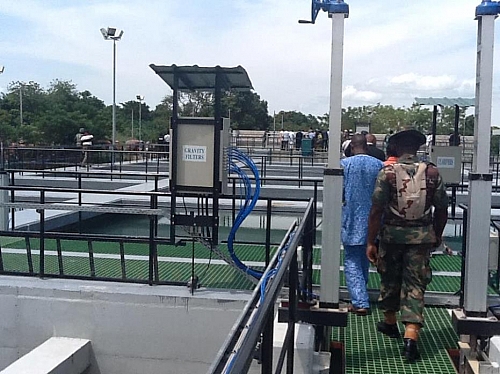The great markurdi water works started in 2007 and was commissioned on the 9th of march 2012 by Ex-president Goodluck Ebele Jonathan. The Great Makrkudi water Plant was aimed to build a water plant that will purify the Benue river water and to supply portable water to feed a large population of Makurdi town on a daily basis for the next Twenty (20) years. It was also aimed at providing quality water that will boost the standard of living of makurdi populace, thereby reducing water scarcity and medical expenses due to poor water supply.
The Makurdi water got its source from the River Benue, this water plant is commonly called the Great Makurdi water works, it was basically constructed to have at about three phases; two of the phases have a capacity of 50,000 m/day or 2,100 m/h, for 24 hours of operation. The second phase of the treatment plant will have a capacity of 100,000 m each day or 4,200 m/h, to be able to take care of the Makurdi and its environs. Presently water plant is said to operate on 50,000cm3, which is believed to be very effective even to next 20 years.
There are five (5) units such as the operator unit, laboratory unit, the environmental pollution catchment unit, the urban monitoring unit and the quality control unit. The turbidity of the river changes each day, most times it records 160 and other times it reads 450 before it is being treated. For the water to be supplied up to 50% to the people of Makurdi, three of the tanks have to open; the depth of the water is 40m down to the treatment tank, there is a very large pipe that lifts the water to the treatment tank, and the diameter of the pipe is 800m at the level that lift is lifting thewater. The water is usually lifted together with particles of sand and debris before it is being selected and treated for human consumption.
Table of Contents
How greatMakurdi water is being treated
Water treatment is a process whereby natural occurring water or raw water from variety of sources is made to pass through series of stages for the purpose purification and clarification, making it fit for human consumption. The treatment processes usually involve the removal of contaminants from raw water to produce water that iscleanenough for human consumption without any impurities that would have led to any adverse health effect. For instance, suspended particles like bacteria, algae,, viruses, fungi and mineral like iron and manganese are some of the contaminants that are removed during the treatment processes.
Processes that are involved in the treatment of Greater Makurdi water plant
- Mixing- water is pump to the treatment plant by an engine, once it arrives at the plant, the pH is tested and adjusted and the water is rapidly mixed with aluminium sulphate (alum), a coagulant that helps the impurities stick together to form bigger particles.The positive charge of alum neutralizes the negative charge of dirt and other dissolved particles in the water. When this occurs, the particles bind with the chemicals and form larger particles, called floc.
- Flocculation– After rapid mixing, the water flows into flocculation tanks, where the flow of water is slowed and the floc has time to grow bigger.
- Sedimentation- Next, the water flows into sedimentation tanks, in these tanks, flocs settle at the bottom since they have become larger for easy removal.
- Filtration– once the water passes through large filters made of sand, gravel, and anthracite. Filtration removes any remaining microscopic particles and microorganisms from the water.
- Disinfection– finally, the water is disinfected to protect it against bacteria. Chemicals like chlorine dioxide and a combination of chlorine and ammonia calledchloraminesare usually added to disinfect the water. Fluoride is also added to support good dental health.
- Distribution– the clean water is then pumped into pipes that deliver it to more than different homes in Makurdi town.
Problem encountered in the great Makurdi water works
- Changes in the turbidity of the water- excessive turbidity, or cloudiness, in drinking water are aesthetically unappealing, and may have effect on human health.
- Non-availability of some good working equipment- various equipment are not functioning in great Makurdi water work, as a result of poor maintenance and mismanagement.
- Explosion of some hazardous agents during the treatment process may cause inhalational injury that may lead to death or damaging of the respiratory tract.
- Lack of a modern distribution network causes some of the pipes to burst and the capacity of the plant is at risk of not being fully utilized.


